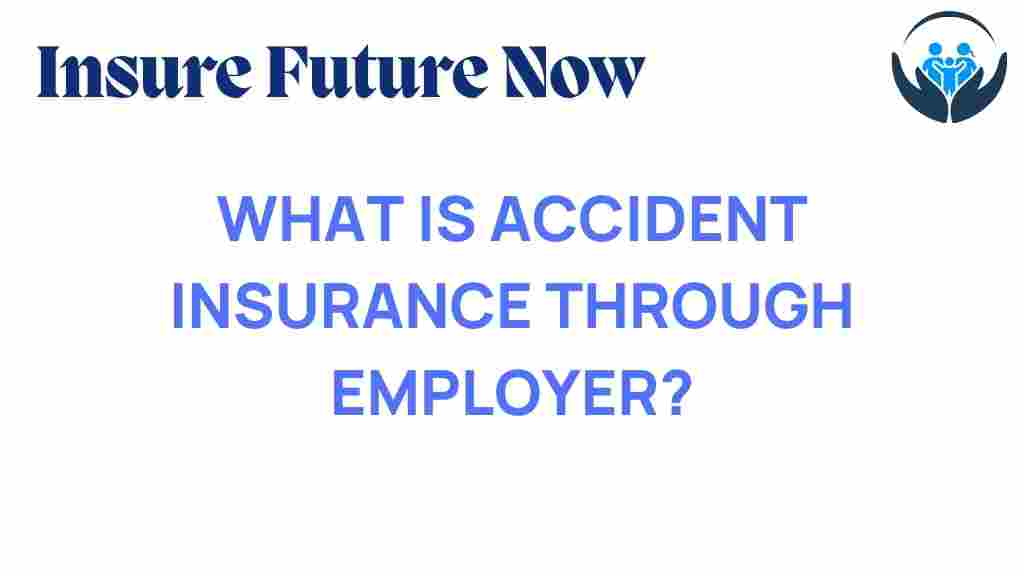Unveiling Accident Insurance: What Employers Offer You
Accidents can happen at any moment, and when they occur in the workplace, both employees and employers face significant challenges. Understanding the intricacies of accident insurance is crucial for employees seeking to safeguard their financial future and ensure robust employee protection. This article will delve into what employers offer in terms of accident insurance, the benefits included, and how it plays a vital role in overall workplace coverage.
Understanding Accident Insurance
Accident insurance is designed to provide financial assistance to employees who are injured due to unforeseen incidents while on the job. Unlike typical health insurance policies, accident insurance offers specific coverage for injuries sustained in accidents, providing a safety net that can help mitigate the financial burdens associated with medical expenses, lost wages, and other related costs.
The Importance of Employer Benefits
Employers play a pivotal role in offering accident insurance as part of their employee benefits package. By doing so, they not only comply with legal requirements but also enhance the overall employee protection strategy. This contributes to a positive workplace environment and can improve employee morale and retention rates.
Key Benefits of Accident Insurance
- Financial Security: Employees benefit from peace of mind knowing that they are covered in case of an accident.
- Comprehensive Coverage: Covers a wide range of incidents, including slips, falls, and other workplace accidents.
- Supplemental to Health Insurance: Provides additional coverage that complements existing health benefits.
- Risk Management: Helps employers manage risks associated with workplace injuries.
How Accident Insurance Works
To make the most out of accident insurance, it’s crucial to understand how it operates. Here’s a step-by-step breakdown of the process:
Step 1: Enrollment
When an employer offers accident insurance, employees typically have the option to enroll during the onboarding process or during open enrollment periods. It’s essential for employees to review the policies offered and choose the coverage that best suits their needs.
Step 2: Premium Payments
Employees may be required to pay a portion of the premiums for their accident insurance policy. Understanding the cost involved is critical in assessing overall financial commitments.
Step 3: Filing a Claim
In the event of an accident, employees need to follow specific procedures to file a claim. This usually involves:
- Notifying the employer about the incident.
- Filling out necessary claim forms.
- Submitting medical documentation and other required information.
Step 4: Receiving Benefits
Once the claim is approved, the employee will receive benefits, which may include:
- Medical expense reimbursements.
- Compensation for lost wages.
- Payment for specific injuries as outlined in the policy.
Types of Accident Insurance Policies
Employers may offer various types of insurance policies under the umbrella of accident insurance. Understanding these can help employees make informed choices.
1. Individual Accident Insurance
This type of policy provides coverage for individual employees and is tailored to their specific needs. It typically covers various incidents and injuries that may occur during work hours.
2. Group Accident Insurance
Group policies are designed for multiple employees, offering a more affordable option. These policies often provide basic coverage for common workplace accidents.
3. Short-Term Disability Insurance
While not strictly accident insurance, short-term disability insurance often complements accident coverage by providing income replacement for employees unable to work due to severe injuries.
4. Long-Term Disability Insurance
Similar to short-term disability, long-term disability insurance offers longer-term financial support for employees who face prolonged recovery periods following serious accidents.
Choosing the Right Accident Insurance
When selecting an accident insurance policy, consider the following factors:
- Coverage Amount: Ensure the policy offers sufficient coverage for medical expenses and lost wages.
- Exclusions: Be aware of what is not covered under the policy.
- Claim Process: Understand how to file a claim and the timeline for receiving benefits.
- Premium Costs: Evaluate the affordability of the premium payments relative to the coverage provided.
Common Questions About Accident Insurance
What is the difference between accident insurance and health insurance?
While both provide financial coverage for medical expenses, accident insurance specifically addresses injuries resulting from accidents, whereas health insurance covers a wider range of medical issues, including illnesses and routine care.
Are employers required to offer accident insurance?
While it’s not mandated by law for all employers to offer accident insurance, many choose to include it as part of a comprehensive benefits package to enhance employee protection.
Can I purchase accident insurance on my own?
Yes, individuals can purchase personal accident insurance policies independently, but many employees find it more beneficial to take advantage of employer-sponsored plans.
Troubleshooting Tips for Accident Insurance Claims
Filing a claim can sometimes be overwhelming. Here are some troubleshooting tips to ensure a smooth process:
- Documentation: Keep all relevant documents, including medical records and incident reports, organized and accessible.
- Follow Up: Don’t hesitate to follow up with the insurance provider if you haven’t received updates on your claim.
- Understand Your Policy: Familiarize yourself with your policy’s terms and conditions to avoid surprises.
Conclusion
Understanding accident insurance is essential for both employees and employers. By offering comprehensive workplace coverage, employers not only fulfill their legal obligations but also foster a culture of safety and security that benefits everyone in the organization. Employees who leverage these employer benefits can enjoy greater financial security and peace of mind, knowing they are protected against the unexpected.
For more information on workplace safety and employee benefits, consider visiting this resource.
By investing time to understand accident insurance and making informed choices, employees can better navigate their rights and protections in the workplace.
This article is in the category Coverage and created by InsureFutureNow Team
